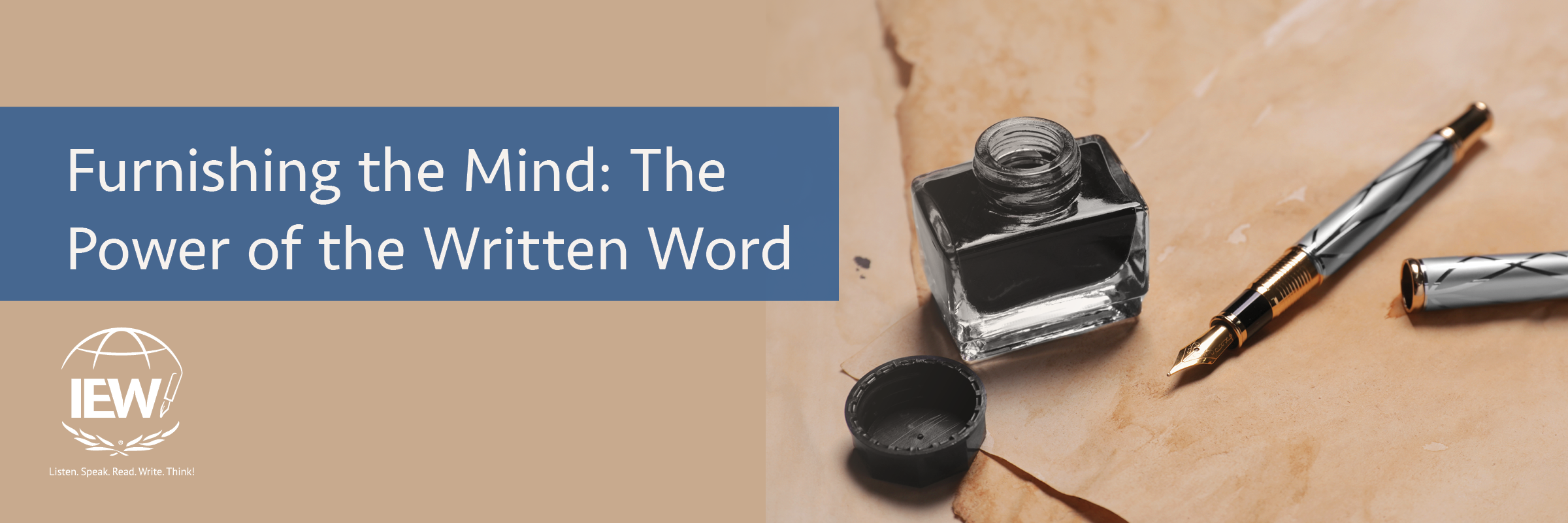
“The pen is mightier than the sword.” Akhiar, a 7th century BCE Assyrian sage, first used this popular idea. Author Edward Bulwer-Lytton coined the specific wording of the quote commonly used today in his 1839 play Richelieu: Or the Conspiracy. Thomas Jefferson later wrote to Thomas Paine, “Go on then in doing with your pen what in other times was done with the sword.” Throughout history, Napoleon Bonaparte, Joseph Smith, Mohammed, William Shakespeare, Erasmus, and others have used variations of this phrase. This expression conveys that writers, thinkers, and philosophers can have a more profound influence on the world through their words than soldiers can with their weapons. It is a testament to the power of persuasion, education, and the written word in shaping public opinion and bringing about change.
IEW’s mission is to equip teachers and teaching parents with methods and materials which will aid them in training their students to become confident and competent communicators and thinkers. We work to furnish today’s young people with the tools to positively influence their generation. Our methods are designed to develop a student’s organization skills (structure) and artistic flair (style). Inevitably, however, parents and teachers wonder when to worry about the content of the paper as much as the structure and style. In IEW’s early years, Andrew Pudewa heard this question so often that he asked Dr. James Webster.
In the podcast “The Mighty Pen – Teaching Students to Change the World through Language” (Episode 269), Andrew Pudewa and Julie Walker discuss how Dr. Webster answered this question. Dr. Webster’s answer was ”Never”—not in high school, not in college, not even in graduate school. He reasoned, “A bad idea well-presented can be more effective than a good idea poorly presented. History has proved this.” The quality of the presentation affects the perception of the message. In Unit 4 of IEW’s Teaching Writing: Structure and Style® teacher training course, participants learn Dr. Webster’s edict: “Hands off content; hands on structure and style.” Sticking to Webster’s edict and truly keeping hands off content, teachers give students the ability to write what they are actually thinking and the freedom to develop their own thoughts.
However, surely content does matter if teachers are to equip students to impact the culture for good. With IEW’s methods and materials, developing writers begin to choose precise and concise words to use in their compositions. As they learn to carefully read source texts, students grow from picking interesting facts, to discerning the facts important to their topic, and finally to including those relevant to their thesis. Practicing the various sentence openers and clausal dress-ups, they eventually build purposeful sentences to convey complex thoughts. Just as students use new stylistic techniques awkwardly until they have had sufficient practice, sometimes their thoughts and ideas can be equally as awkward until they have had sufficient time to learn and practice the logic and rhetoric skills to construct mature arguments. Practice expands their capacity for formal thinking.
Andrew compares IEW’s Structure and Style® method of teaching writing to plastic building-block sets. When children first receive a set, they put it together according to the instructions. Eventually they take those same pieces and construct their own creations. Similarly, the Structure and Style methodology gives students the pieces (structure, style, and content) and expectations (the checklist) so that they can assemble their words and have a successful and satisfying experience until their writing ability and thinking matures.
The key to helping young people develop mature ideas is furnishing their minds with great ideas. Writers can only write about what they know. C.S. Lewis’s experiences during World War I, the Celtic mythology his nanny read to him, and his relationships with the professors of his Oxford literary club inspired the fantastic stories contained in The Chronicles of Narnia. Benjamin Franklin developed his own writing style by outlining the key ideas of important literature and paraphrasing it. William Shakespeare benefitted from a Renaissance education that encouraged discourse and debate. Beginning when they are young, expose children to words and ideas. Help them memorize poetry to store rich vocabulary and interesting syntax in their brains. As they grow older, have them practice delivering important historical speeches filled with sound rhetoric. Have them read classic literature and biographies that help them understand the human condition. Go to museums and historical sites. Discuss current events. These activities give writers a repertoire to work with.
If bad ideas presented well have inspired evil, we must fill students with the good and the true and equip them with the skills to communicate honorable ideas and present them powerfully if they are to influence their world with goodness and truth.
by Andrea Pewthers
